


Part 4: March in Northern Italy: Milan, Genoa, Lake Como, Lake Lugano, Pavia
I spent eight days looking at Italy "through fresh eyes" - doing the classic first timers trip to Italy - Venice, Florence and Rome. This was my 13th trip to Italy, but it was the first for my friend Crista and I really enjoyed showing my favorite country to a 'newbie'. I'd been to Rome seven times, Venice five - most recently just last July but I wanted to show her all the 'must sees' and it turned out to be a chance for me to see what you really can see in just a week. We had a great time, and while we certainly didn't see everything, we hit most of the highlights, had time for some leisurely drinks, gelatos and meals and never felt rushed. Unfortunately for her, Crista had to go back to work but I had an additional 5 days.
I've been on a quest the last few years to 'research' places to go where it's 'nice' when it's not 'nice' where I live (northeastern US). So this was part of my research mission to see how northern Italy is is the early spring.
Although the first week we were looking at cool rainy weather in Milan and areas around it – especially the lakes – and thus made a last minute switch to Rome (where we had 70 and sunny), by the second week Milan had great weather. After one morning of drizzle the sun came out and stayed out for five days, temps climbing from the low 60s to over 80.
All over Lombardy and the Veneto – green grass, tons of pink and white flowering fruit trees, other trees just starting to bud out, dandelions, little white wild flowers, jasmine, forsythia, daffodils, tulips, wisteria.
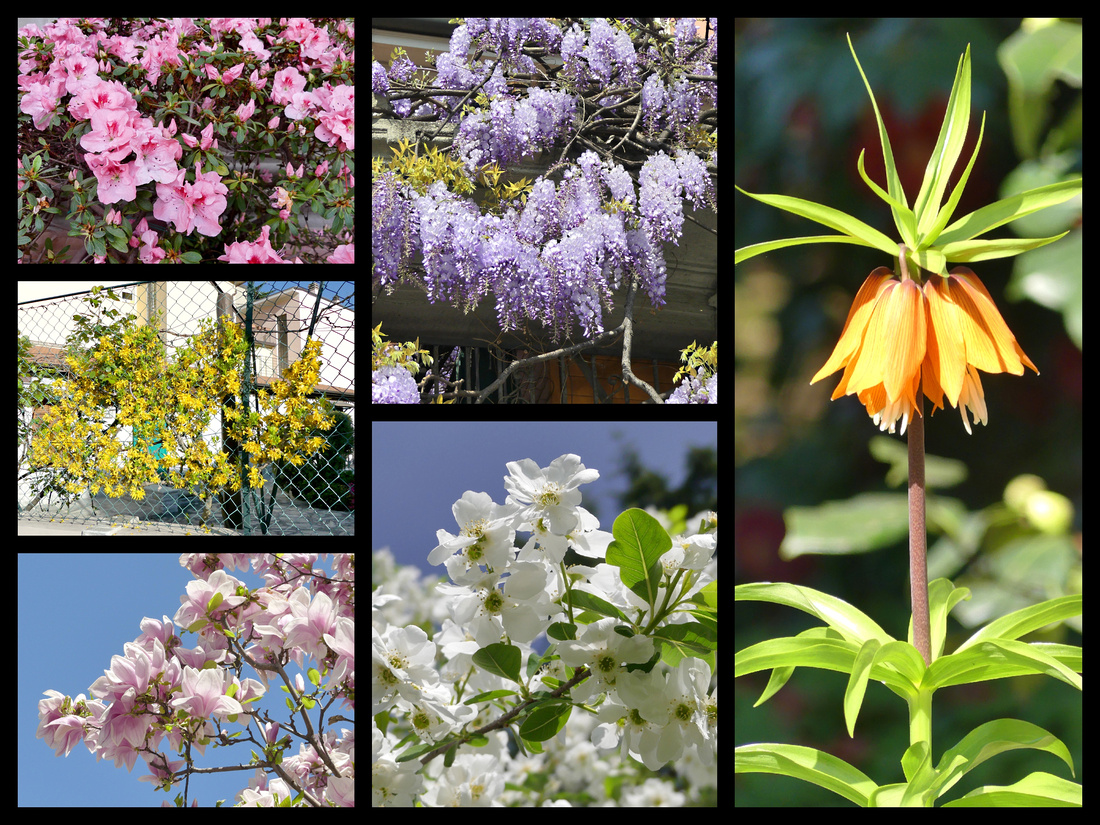

This was my third visit to Milan, a city I didn’t even deem worthy of seeing until my 6th trip to Italy. And I still don’t think it’s on a par – from a tourist standpoint – with Rome with it’s ancient ruins and Baroque piazzas, or Renaissance Florence, or ‘like-no-where-else-Venice’. But it’s a nice city. The Duomo and Galleria and surrounding piazza is incredible and most certainly ‘worth’ seeing. And it’s got some nice shopping/strolling streets, a pretty decent center city castle whose courtyards you can wander around for free, and a pretty park. And Milano Centrale is one of the ‘best’ train stations in Europe. A huge Fascist era building that itself is worth seeing if you like train stations. But I think the best reason to plan a few days in Milan is that it’s transportation connections are so good. It’s got two airports and if you’re traveling from anywhere south to the rest of Europe, or going from one coast to the other in Italy, you most likely will go through Milan. And it’s so central there are numerous really worthwhile day trips possible. On this trip I did Pavia ( ½ hour by frequent train), Lake Como and Lake Lugano (both less than an hour), and Genoa, which at 1 ½ hours is close to my limit for a day trip, and now that I’ve been there I know next time I will plan to stay a few days, but it was a totally enjoyable day trip from Milan. Other day-trips easily done from Milan include Bergamo, Cremona, Brescia and Parma.
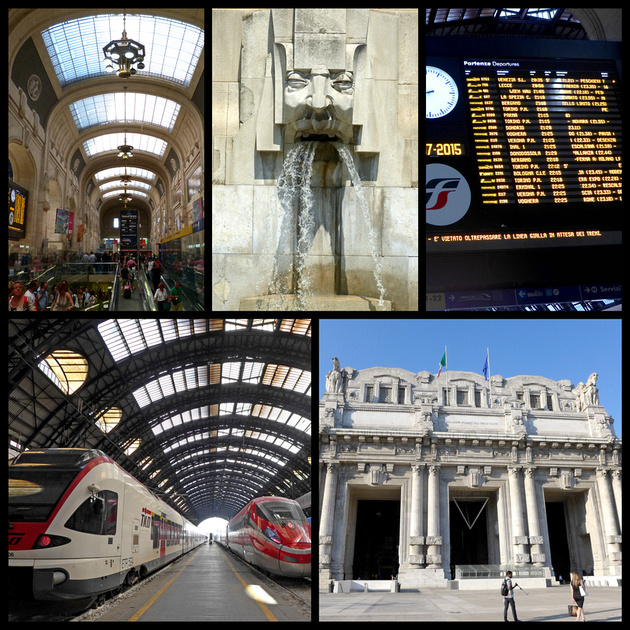

Sunday, March 26, 2017 Rain in am, sunny and 63 rest of day. Spent a lovely six hours exploring Pavia. Loved it.
Pavia is a university city with Romanesque and medieval buildings and an interesting historic center set on a river. Founded by the Romans, Pavia reached its greatness over 1300 years ago when it became the capital of much of the Italian peninsula. A comfortable provincial town founded on an easily defendable stretch of land alongside the confluence of the Po and Ticino rivers. Pavia barely gets mentioned in guidebooks and travel forums, and when it does it’s because it’s only 8 km from the Certosa di Pavia, a huge monastery complex, which I ended up not getting to as I so enjoyed the city itself I spent all my time there.
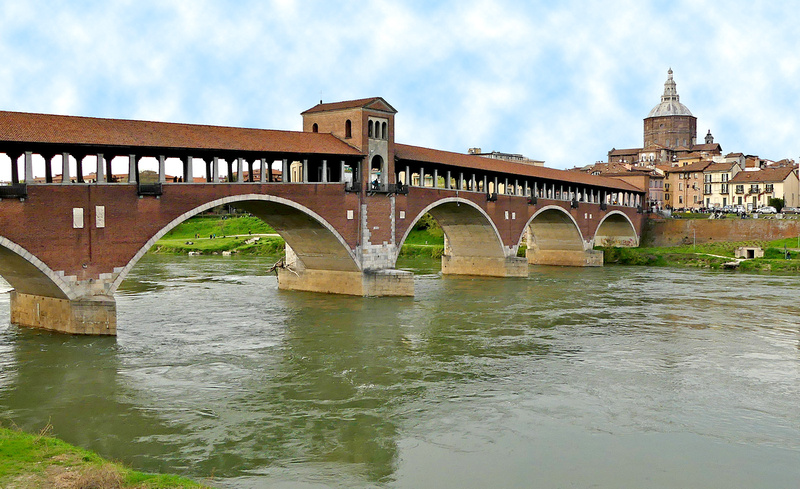

At first Pavia seemed to me a bit like Vicenza – quiet, prosperous, pretty - but not very interesting. The Duomo was impressive but not particularly pretty from the outside and looked closed. Most of the stores were closed (it was Sunday). I found the covered bridge – Ponte Coperto - and that was quite nice. It’s a reproduction of a 14th century bridge destroyed during the war, which itself was built near the site of a Roman bridge over the Ticino river. I sat on a bench in the sun for half an hour and watched locals walk their dogs and kids. Then explored the center – I found a TI Office which looked closed but there was a guy in there who let me in and gave me maps and was extremely helpful telling me where to go. Having the map really helped (I left my relatively lousy guidebook map in the hotel). There are posted maps all over town but without having one in my hand I kept forgetting where to turn. With the map and his instructions I easily found the main square, Piazza della Vittoria (really nice, lots of outdoor cafes and pretty buildings).
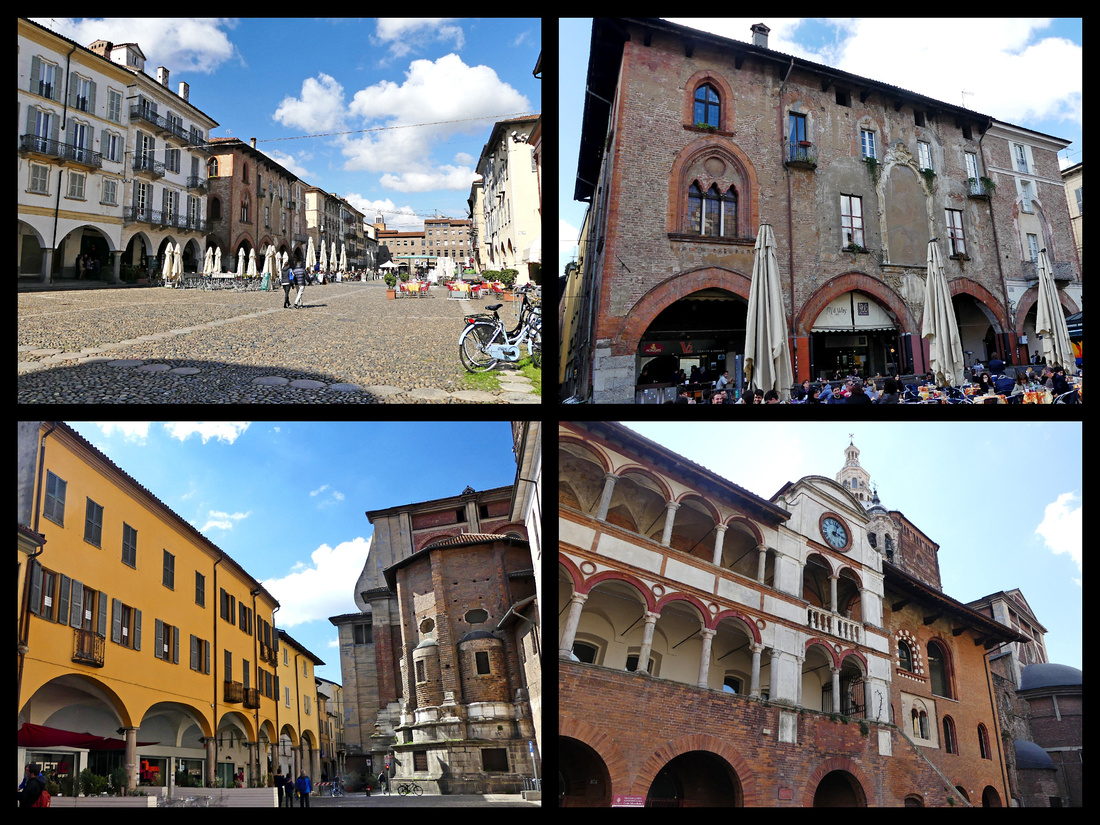



The University, one of the oldest in Europe (founded 1361 but possibly based on a school here from 825). There are at least 12 different courtyards and gardens, all arcaded, beautiful. The architecture is a mix of baroque and neo-classic. Three of the medieval towers (there were once 100, now only about 5 left, but they are quite striking) are in a park like setting behind the University.
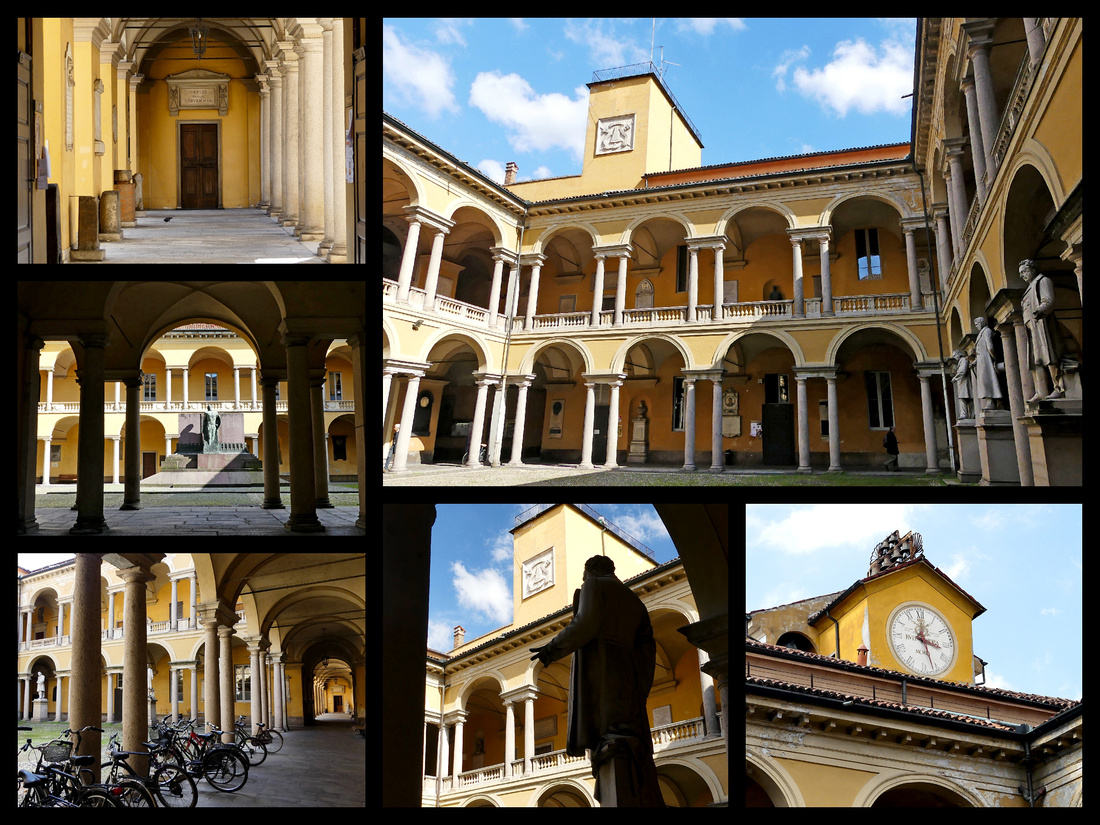



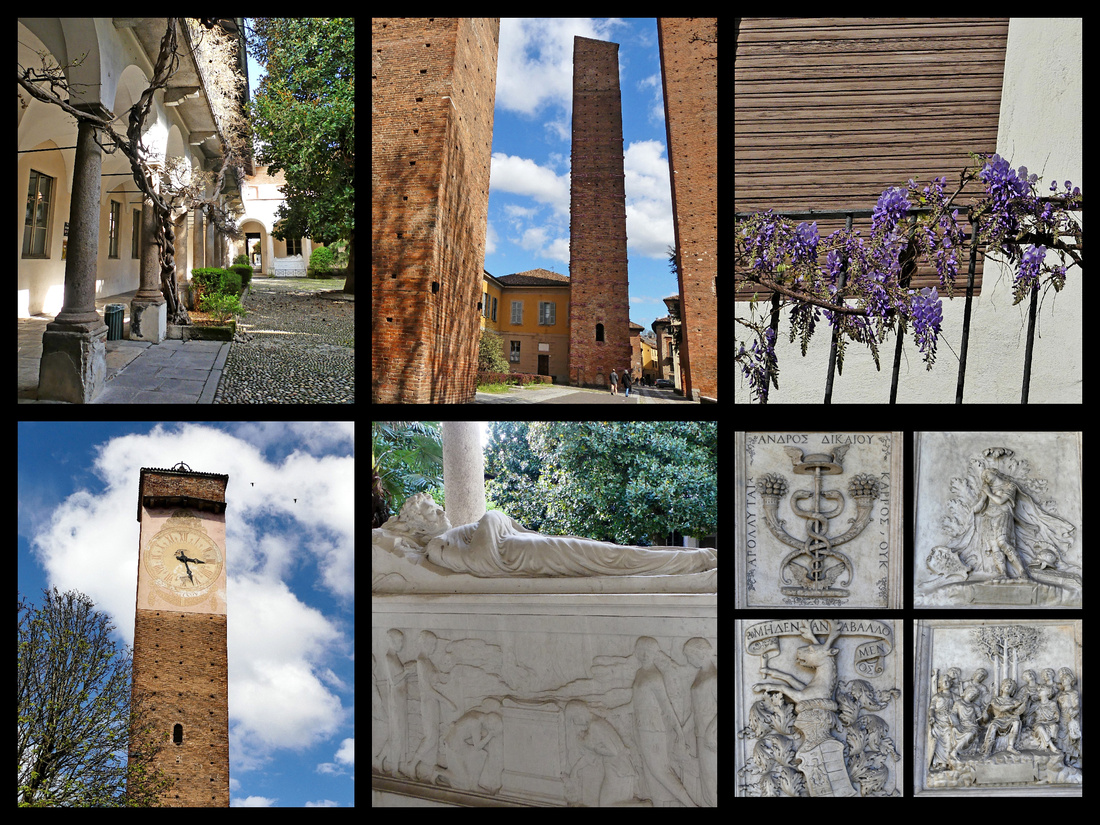

The Castello Visconteo, (1360s) looks like a small fortified castle but was actually used as a private residence, set in a lovely park with people, kids, and dogs and everything green and with wildflowers blooming.
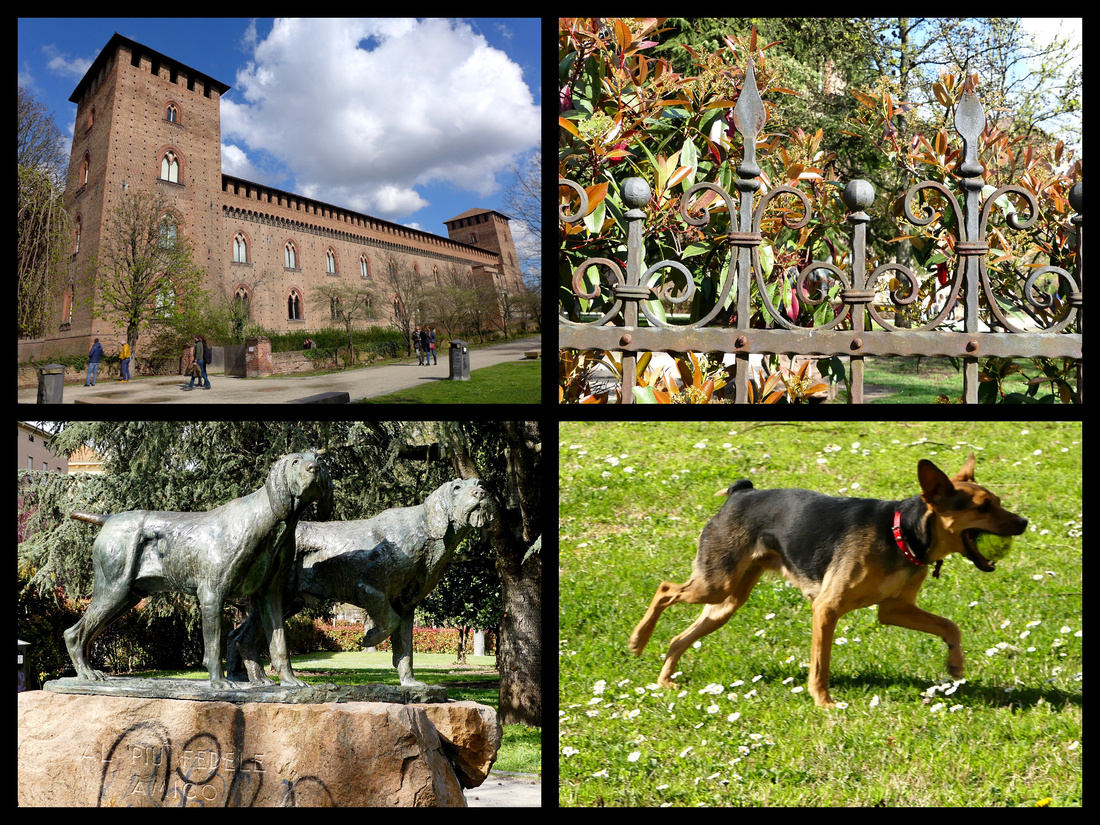

There are plenty of churches – none terribly beautiful on the outside, but all were huge and gorgeous on the inside. San Michele (between the bridge and main part of town) had extensive carvings on the sandstone façade including griffins, dragons and other beasts locked in a struggle with people representing the fight between good and evil. Inside was huge and impressive but my favorite was the lower level crypt/chapel – very Romanesque.


Another, Basilica of San Pietro in Ciel d’Oro, (close to the castle) 1132 is similar but of brick instead of sandstone but also has a lower level chapel that feels very old (and that strange feeling I get in some very old churches that is a combination of spooky and religious). In both churches there was singing/chanting coming from unseen voices.


A third church, Santa Maria del Carmine (towards the main piazza), also of brick was less interesting but it did have frescoes featuring the town’s bridge and other sites and some secular scenes. All were free to enter, and none had more than a handful of tourists.
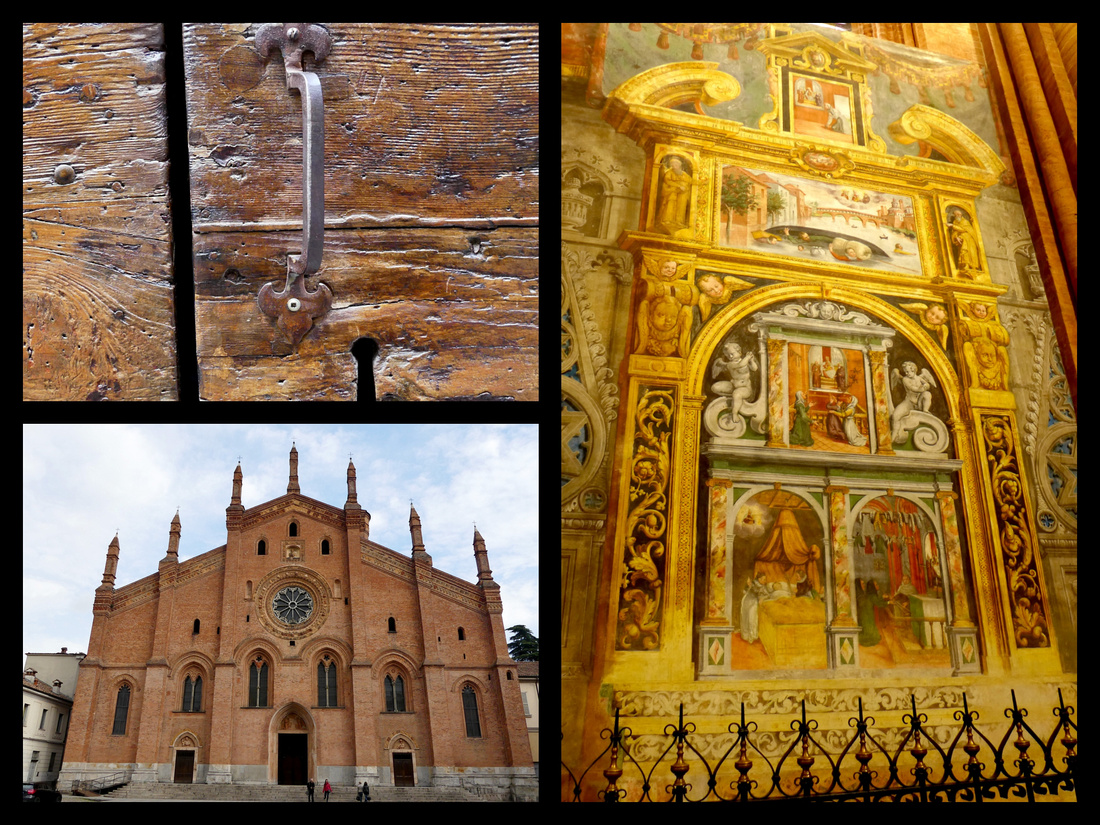

I went past the Duomo a second and this time it was open and gigantic –and very white inside (different from the others which were all much darker). There was a mass just starting which actually added to the effect. Outside was a band performance and little festival. Earlier I’d passed the band leading a parade of people (many of them children) holding signs. Not sure what they were celebrating but everyone seemed very happy. Outside the Duomo the band was playing “YMCA” – then to walk into this incredible church with a mass (in Italian obviously but to me it sounded like Latin) – quite the contrast.
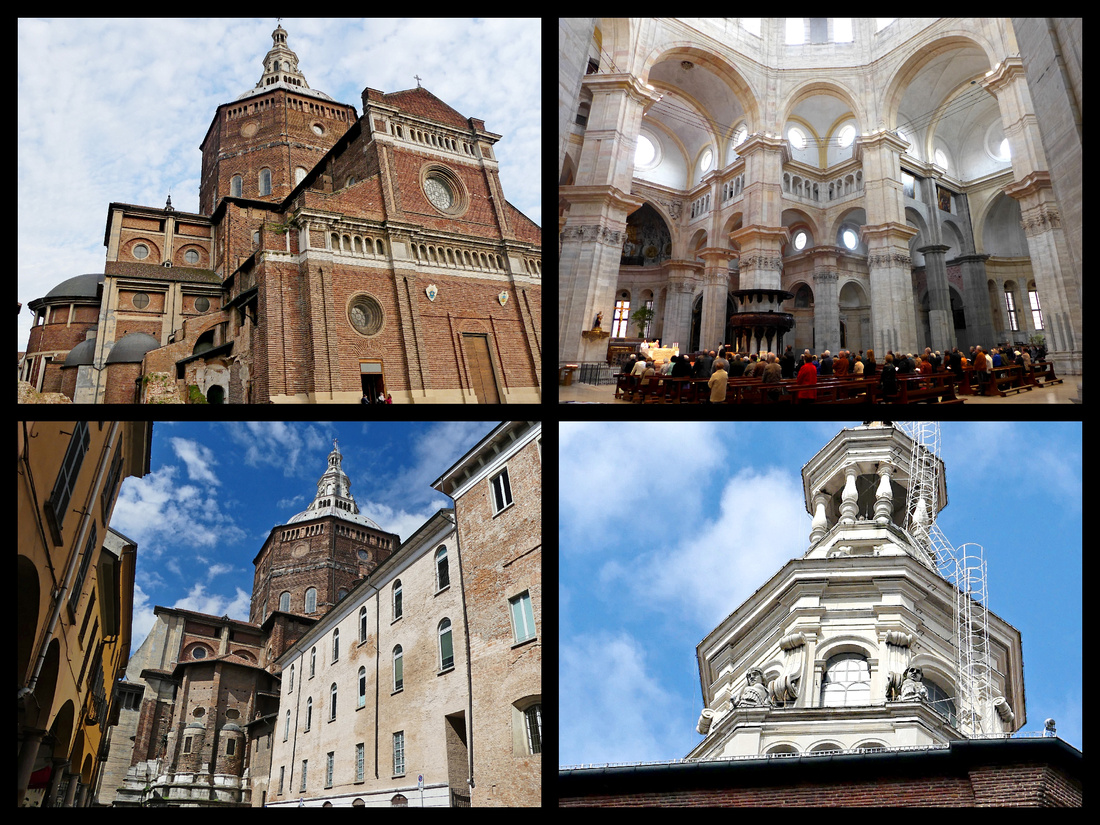

Back to the bridge as I saw a photo of it from the opposite side (didn’t walk across it the first time) and the view is better from that side. Finally headed back towards the train. The whole town was out shopping/walking/eating gelato. Huge difference from the sedate feeling in the early afternoon (it was now after 5pm). Tons of dogs of all kinds, lively atmosphere, birds singing in back streets/along the river, some street performers, the band (parade), the singing in the churches, wisteria, forsythia, trees just budding out, warm sun, cool breeze. Lovely day.


Monday, March 27, 2017 - Sunny and 65 – Took 8:10 train to Genoa, arrived just before 10. Walked all over. Took 4:09 train back.
I liked Genoa a lot more than I thought I would. I had figured it would be sort of like Palermo, maybe not even as nice, kind of gritty, rather dark. But it was lovely. Sprawled behind the port area (Italy's biggest) is a dense and fascinating warren of medieval caruggi (tiny alleyways) – and these are kind of dark. But the rest of the city is bright and clean and there are some incredible buildings, including several 16th and 17th century palazzos along Via Garibaldi which are a UNESCO site, and the 19th Century city along arcaded Via XX September which is the main shopping street – with all the usual international chains.
The main Piazza – Piazza Ferrari – separates the old town from the more modern 19th century city, and has a huge fountain which was incredible. 19th century neo Baroque buildings surround it including the ‘Borsa’ and the Teatro Carlo Fellice.


A couple blocks south from Piazza Ferrari brings you to Piazza Dante off which is the ancient main gate to the city, Porta Soprano, still very imposing with two huge towers. Right next to that is the tiniest cloister – no church, just a perfect square little arcaded stone cloister from the 12th century. It is the Cloister of sant’Andrea. Christopher Columbus’s house is supposedly right around here but I didn’t see it.
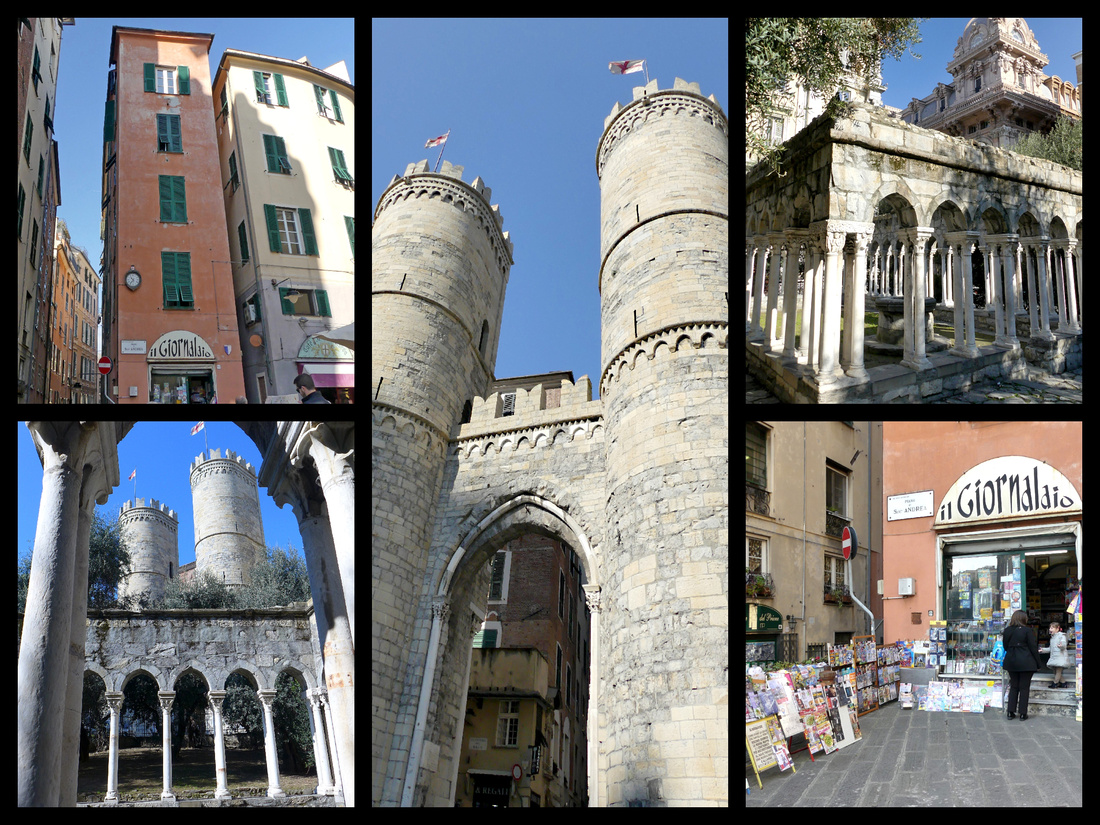

Southwest of Piazza Ferrari is the Chiesa dei Sant Ambrogio e Andrea (big, pretty and yellow, late 1500s) and Piazza Matteotti, home to Palazzo Ducale, the historic location of the Genova Republic' s Government and today is the center of all Genova' s cultural activities.
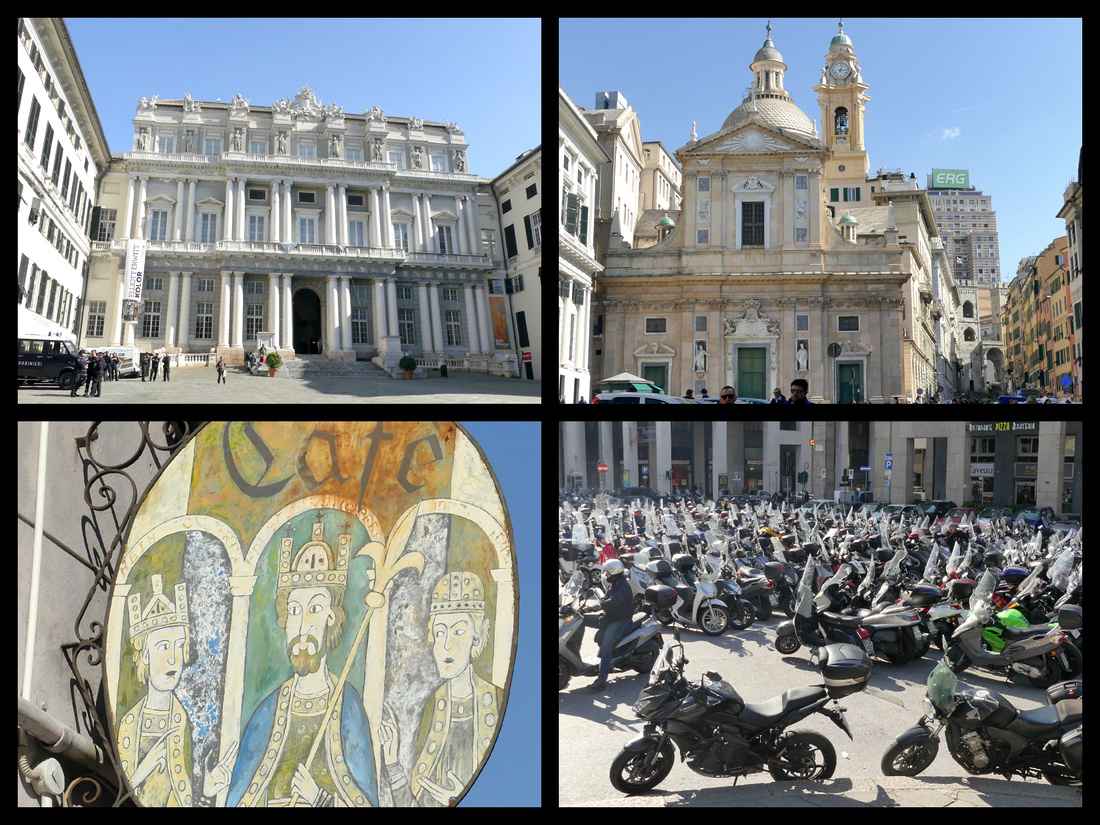

In the other direction from Piazza Ferrari is tiny Piazza Matteo with a cute little black and white striped church. This beautiful little square is the domain of the city’s most acclaimed family, the seagoing Dorias, who ruled Genoa until the end of the 18th century. The church is 12th century and contains the crypt of the Dorias’ most illustrious son, Andrea. Several of the buildings surround the piazza are also black and white striped (like many others in the city) which denotes homes of the most honored citizens.
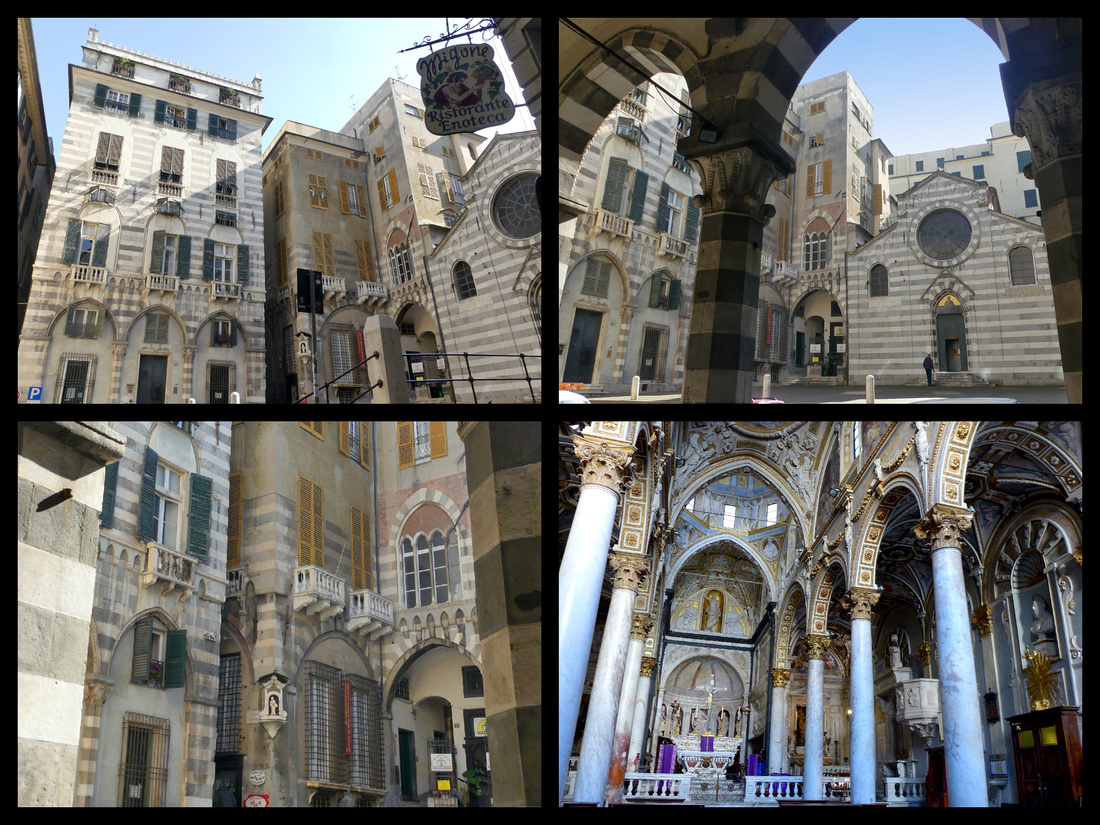

Just around the corner from Piazza Matteo is the larger San Lorenzo Cathedral – also black and white stripes with a pair of nice lions guarding the stairs leading to it. It’s Romanesque-Gothic, begun in 1160, remodeled in 1307 with a Renaissance dome added in 1557. From here Via San Lorenzo is the ‘main’ street leading down to the port. On the map it looks like a big busy street but in reality it’s narrow and pedestrianized, not all that much wider than the narrow, atmospheric alleys all around it.


It opens out onto the area just behind the Harbor. Via di Sottoripa is a covered street with lots of eateries. The back of Palazzo San Giorgio is here. The back of the building looks like a medieval castle, but the front (and side) is bright, beautifully painted with pastel colors including a huge depiction of Saint George slaying the dragon. The place is absolutely gorgeous, only slightly diminished by being right across from the large highway overpass.
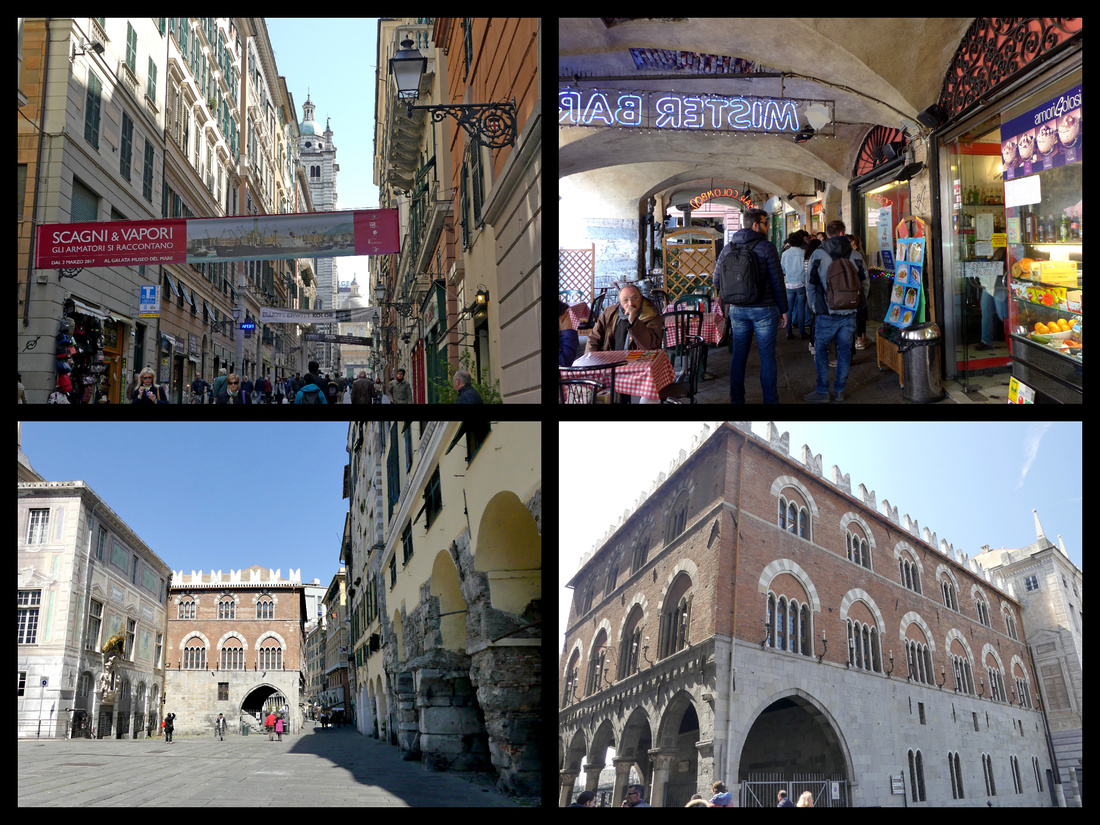



There is a relatively busy street even under the highway, but there are lights and crosswalks and it’s easy to see the harbor from the main side of the road. Porto Antico, totally revitalized over the past two decades, it’s old warehouses converted into exhibition spaces, concert halls, museums and waterfront cafes. It’s Italy’s biggest port, but the industrial shipping and cruise ship areas are way off to one side so the area directly in front of the city area I just described is all open and inviting. There is what is supposedly the ‘best’ aquarium in Europe (I was really sorry not to have time for it) which includes a huge round Biosphere which stretched out into the harbor. The Galeone Neptune is certainly an eye catching addition to the harbor. It’s a replica of a 17th century Spanish galleon. It was built in 1985 for Roman Polanski’s film Pirates. But it sure is pretty.
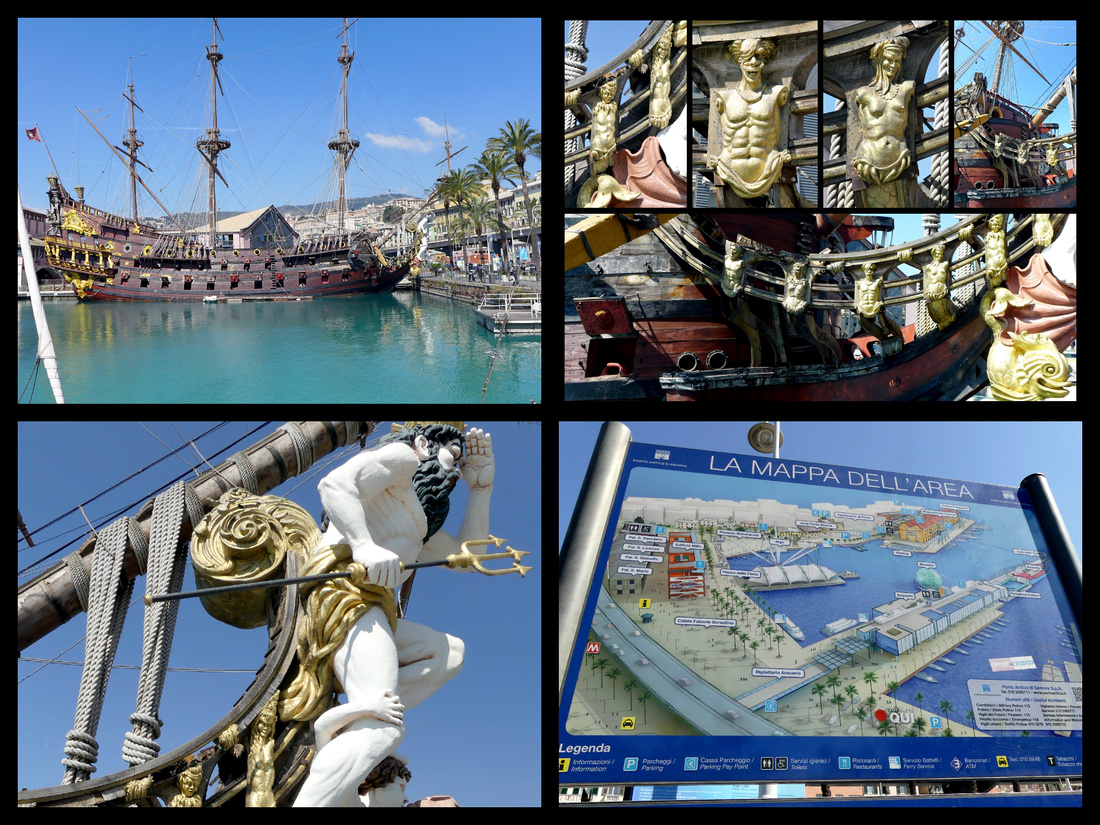

Another eye catching thing on the other side of the aquarium is Il Bigo – a ride in a capsule strung from what is supposed to look like a ships crane, that gets lifted high over the port. Next to this is an old warehouse renovated to house a huge ‘Eataly’ and numerous other shops and restaurants. There are sailboats, yachts, sightseeing boats. Modern art sculptures, renovated old cranes. The whole area is delightful (especially on a blindingly bright day with temperatures in the high 60s) and I walked quite a ways just taking it all in.
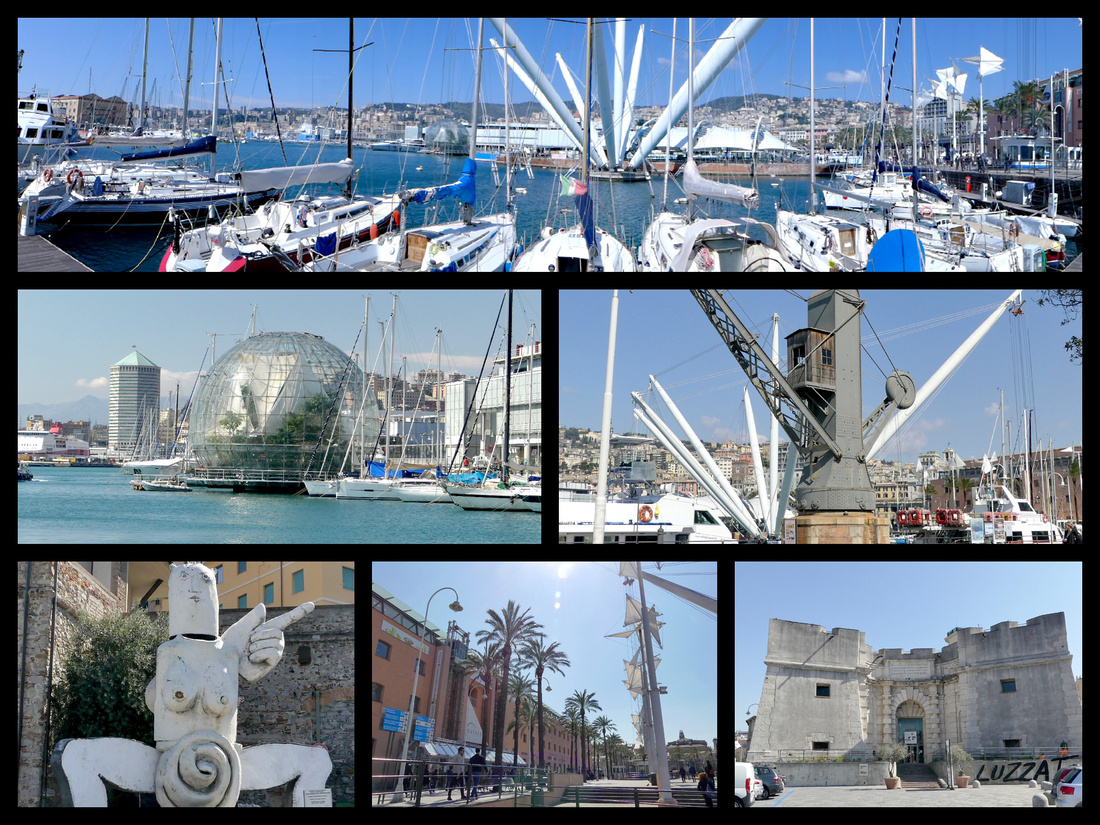

I could have stayed down by the waterfront for the rest of the day but I wanted to see the street which is a UNESCO World Heritage Site so I made my way back inland and up through the narrow caruggi. The streets here are indeed dark and narrow and the few piazzas are so tiny you can hardly call them piazzas. But Piazza San Luca has a pretty little church and Piazzi Banchi is a tiny but busy little square with an interesting kind of elevated church.
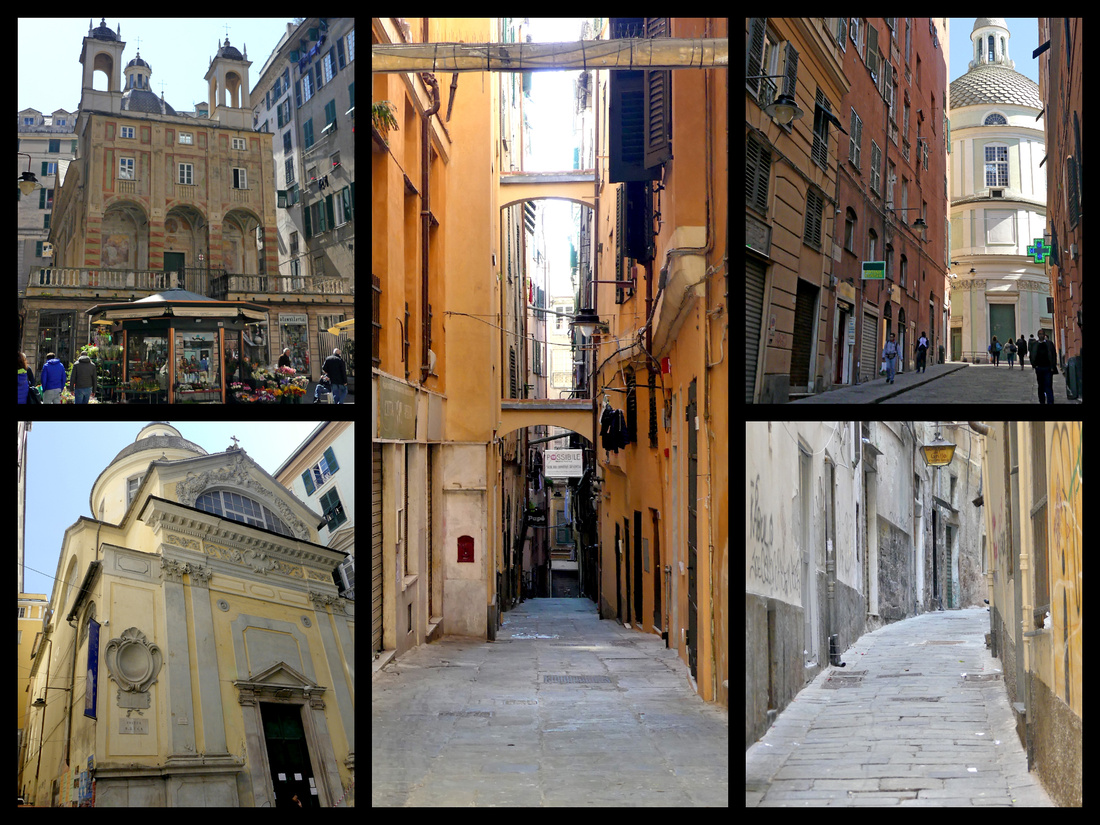

There are over a hundred Renaissance and Baroque palaces on the Strade Nuove (‘New Streets’), built between the 16th and 17th centuries and 46 of them are collectively listed as a UNESCO world heritage site, the main ones on Via Garibaldi, a few blocks inland from Piazza Ferrari. Descriptions of Via Garibaldi make it sound like a grand boulevard but it is actually a narrow pedestrianized street which feels even more hemmed in by the large palazzos on both sides. Palazzo Rosso, Palazzo Bianco and Palazzo Tursi are the most well known.
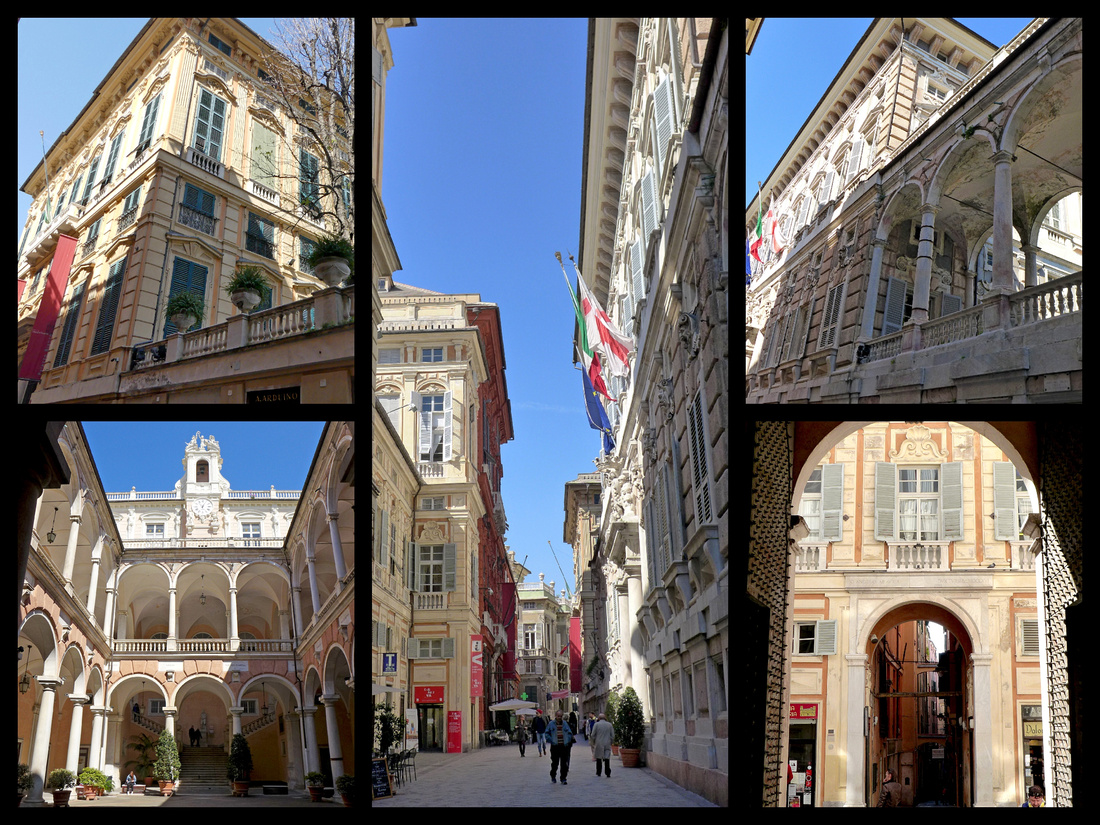

Just a block past Via Garibaldi is Piazza del Portello, a busy traffic square, which has the entrance to the Art Noveau lift up to a belvedere with great views of the lower city, the water and the hillsides which are the ‘suburbs’ of Genoa, with pastel colored buildings as far as the eye can see.


Everything was a lot closer together than I expected it would be. From the maps and what I read I figured the hills would be worse and the distances much farther. Genoa is a large city (Italy’s 6th largest I think) but the historic core and the waterfront are close together and it’s very walkable. There is a lot I didn’t get to and I definitely plan to come back. Still, I walked a ton (though never considered taking the metro which I though I would have to). The route I took is only about 5 miles, though of course I double around a lot so did at least twice that.
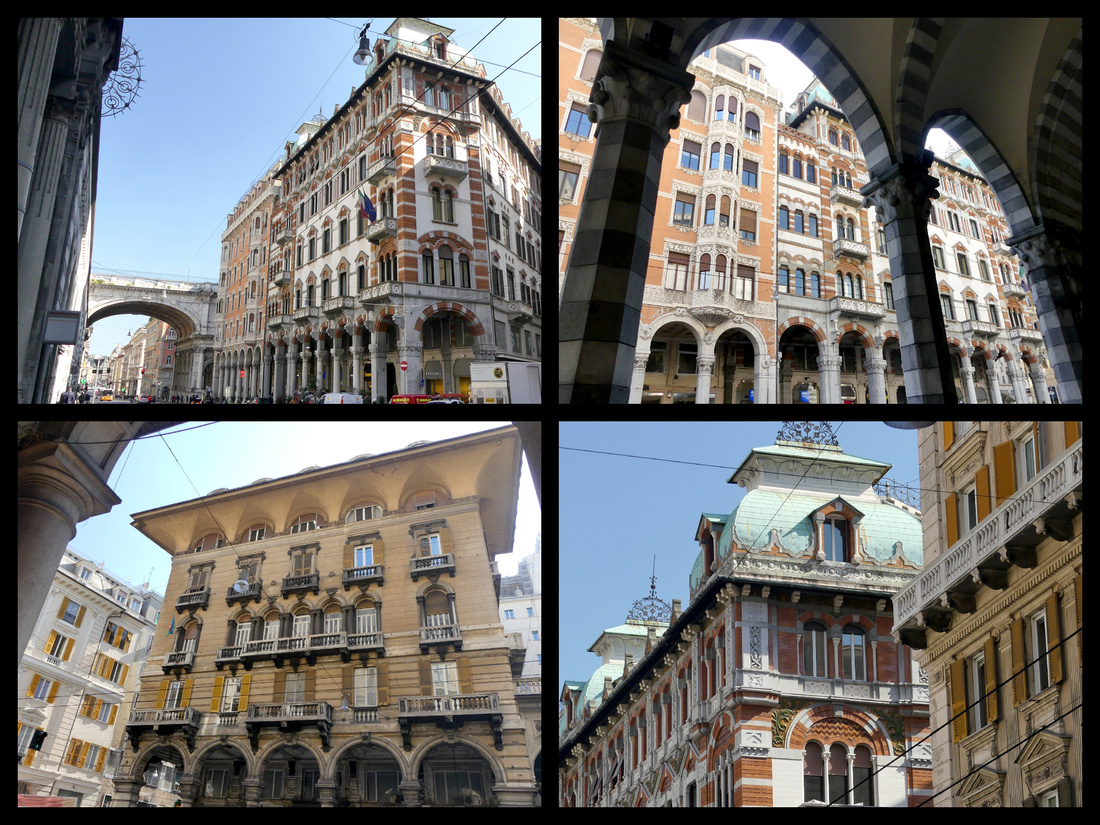

Via XX Septembre arcaded shopping street
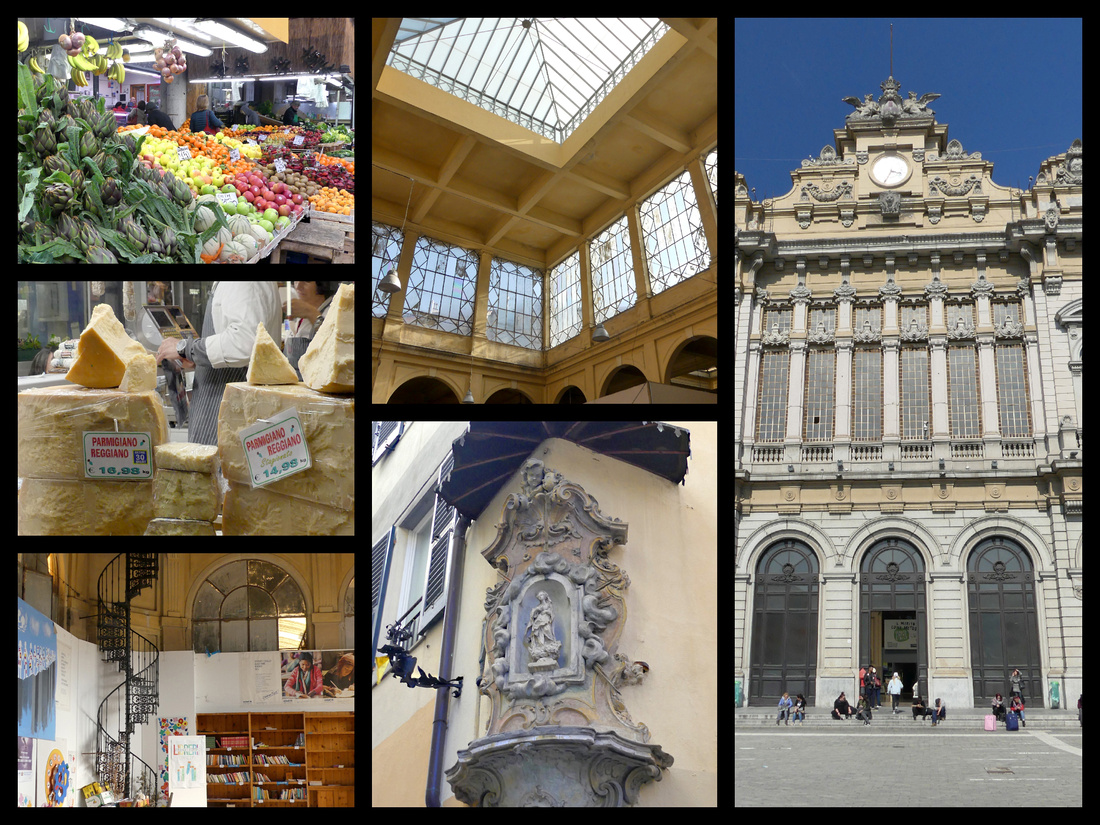

Mercato Orientale (left and center) on Via XX Septembre and one of Genoa's two main train stations, Stazione di Genova Brignole
Tuesday, March 28, 2017 - Sunny and 65
It’s just about exactly an hour from Milano Centrale to Varenna. I bought my return ticket before I left Milano as I had heard the Varenna station is unmanned – which it is, but there is a café at the station and they do sell train tickets there, plus there is a ticket machine. I bought a ‘mid-lake’ ferry pass and took the ferry first to Menaggio for an hour or so, then to Bellagio for another hour or so, and spent the rest of my day in Varenna.
Lake Como in March
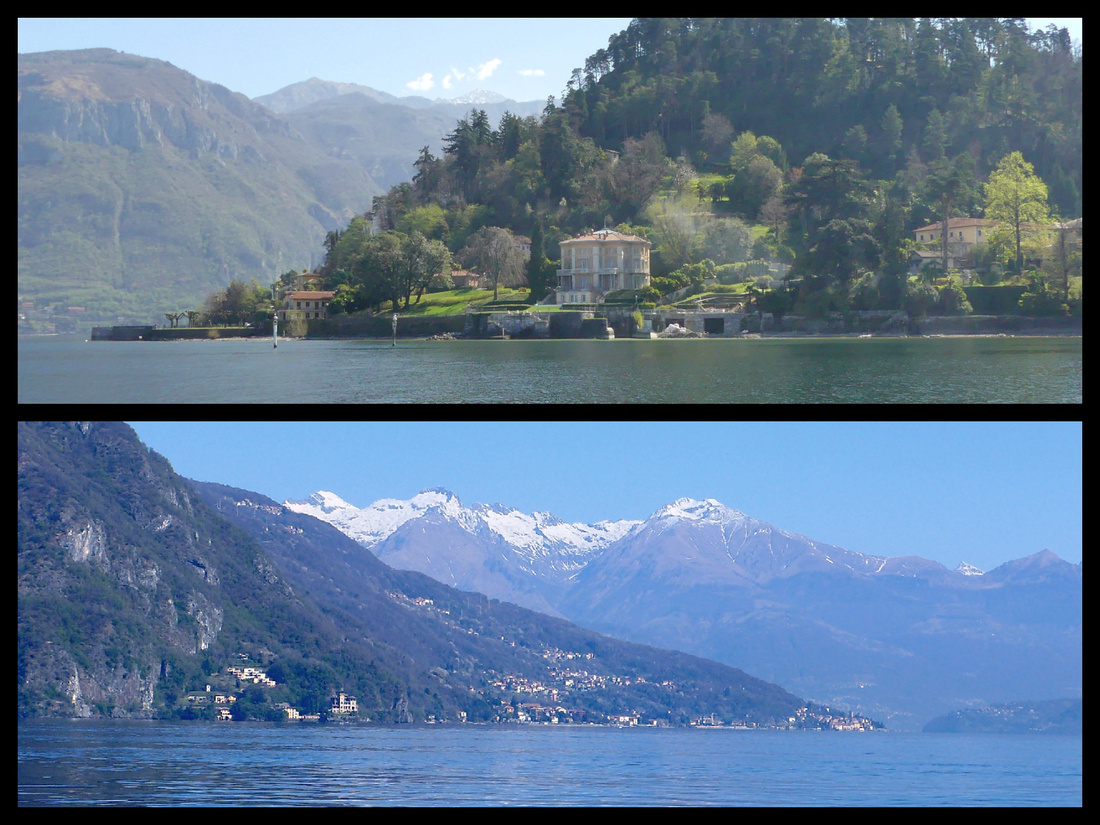

Snow on the higher peaks in the distance. Wisteria, forsythia, dogwood, tulips, daffodils, pansies. Empty boats. A few tour groups in Bellagio but Varenna and Mennagio were empty except for the locals and a handful of independent tourists. Less than half the stores were open but that was enough – not much to buy except overpriced clothes. Plenty of places to get lunch, a drink, gelato.
Bellagio had lots of ‘pre-season’ construction going on, reminded me of Positano in March. In fact, just in general it reminds me of Positano. Almost every shop is a tourist store or eatery, nothing I want to buy. Bellagio is supposed to be the ‘prettiest’ town on Lake Como (a designation which is deserved in the case of Positano) but isn’t. Varenna is far more attractive and interesting with a long lakeside walk with breathtaking views, tons of little steeply stepped stone lanes (most of which are not lined with stores) going up to an attractive little town center with cute church and some real stores scattered in among the tourist ones. I liked it best 13 years ago, and still feel that way. I have no idea why people prefer Bellagio, and probably it’s fame has made it even worse as there appears to be virtually no ‘real’ houses or stores. Menaggio is even less touristy than Varenna. Long wide lakeside promenade and a tiny town center with two attractive churches but overall somewhat less pretty than Varenna.

 Lakeside Promenade in Varenna
Lakeside Promenade in Varenna

 Varenna
Varenna
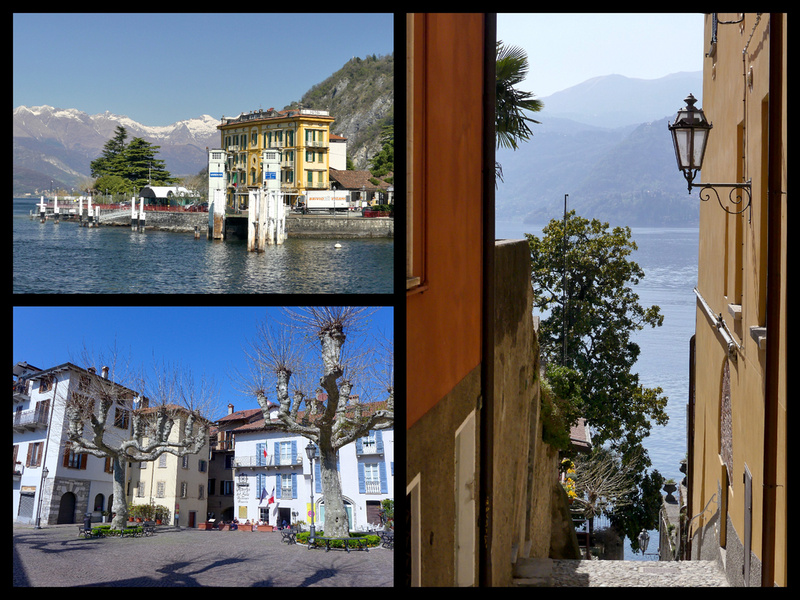
 Varenna
Varenna

 Bellagio
Bellagio
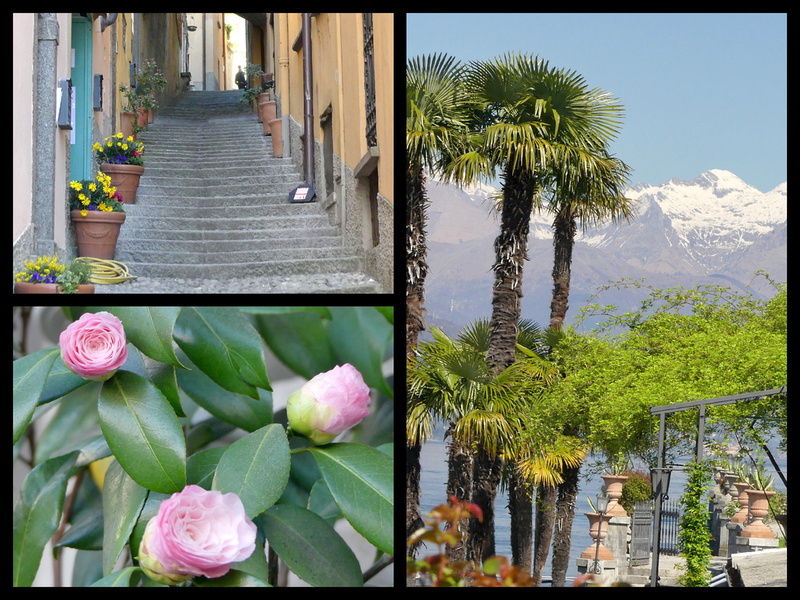
 Bellagio
Bellagio
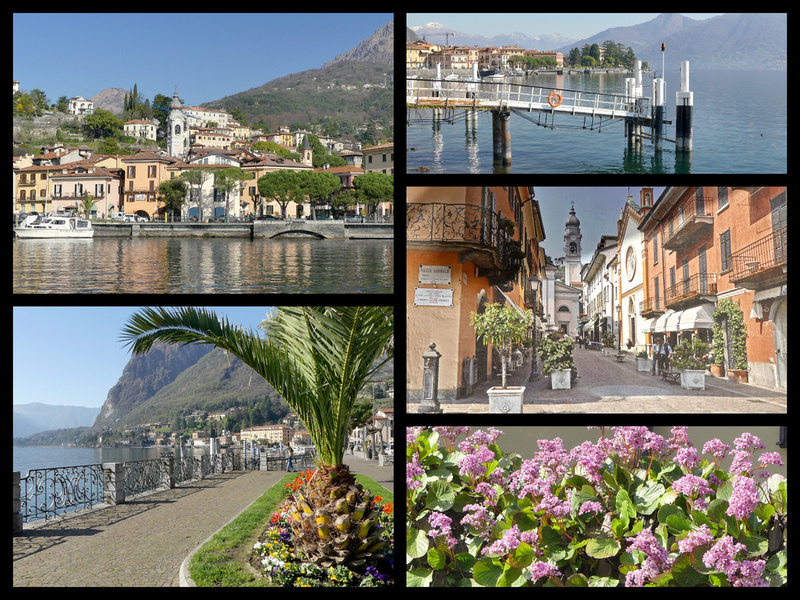
 Menaggio
Menaggio


However, overall, as beautiful as Lake Como is, I really prefer Lake Garda. The mountains are higher and closer (which might be the case with the top half of Lake Como, I have not been there) and the three northern towns on Lake Garda are more interesting and scenic than the Lake Como towns, the lower towns are larger and prettier and then there is Sirmironie.
But the birds were singing, the sun shinning, cool breeze, warm temps. It was lovely. In another month there would be more flowers blooming, more things open – so a more lively atmosphere – but there would be more people too. Other than the chance of clouds/rain being higher in March I think planning a trip to the lakes in early spring is a great idea. As long as you can choose a sunny day (eg plan to stay in Milan and do other things if the weather is bad).
Wednesday, March 29, 2017 - Sunny and 70 - Lugano, Switzerland – OMG what a gorgeous day – 75 and sunny, not a cloud in the sky. Lugano has a magnificent setting, much better even than Lakes Como or Garda. Lugano itself is a medium size city (71,000/140,00 urban area), mostly pretty modern. There’s been a town there for thousands of years but most of the buildings are from the late 1800s and later. The ‘center’ seems to be 1880-1920, some nice arcaded buildings and streets but nothing that feels especially old. And lots of 20th century building – that’s the majority. So not quaint, not especially atmospheric, but what a setting. There is a long promenade (at least 2 miles) part of which is a very nice park. Lots of things in bloom – pink and white flowering trees, dogwood, tulips, daffodils, willows just budding out, palm trees! I love that there you can see palm trees and snow covered Alps at the same time (which is also true of Lake Como). Delightful to walk along the water through the park. Lots of swans (and very tame). Hardly any boats in the water (most still have their winter covers on and pulled up on the shore) so that looks different than summer but otherwise it could have been June (probably more in bloom even than in than in June).




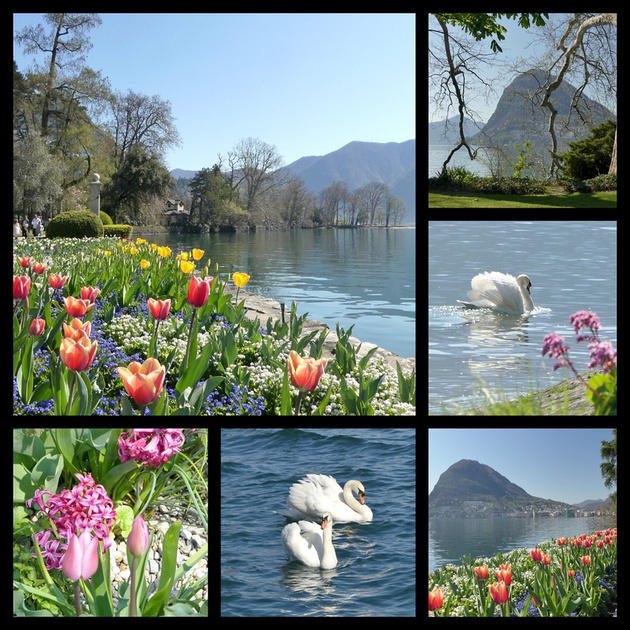

I walked all over – the ‘center’ is tiny, one main square and a few minor ones – lots of chain and designer stores, but nothing terribly interesting (and virtually nothing touristy). Italian is the main language though some signs are in French and German as well (not much in English).
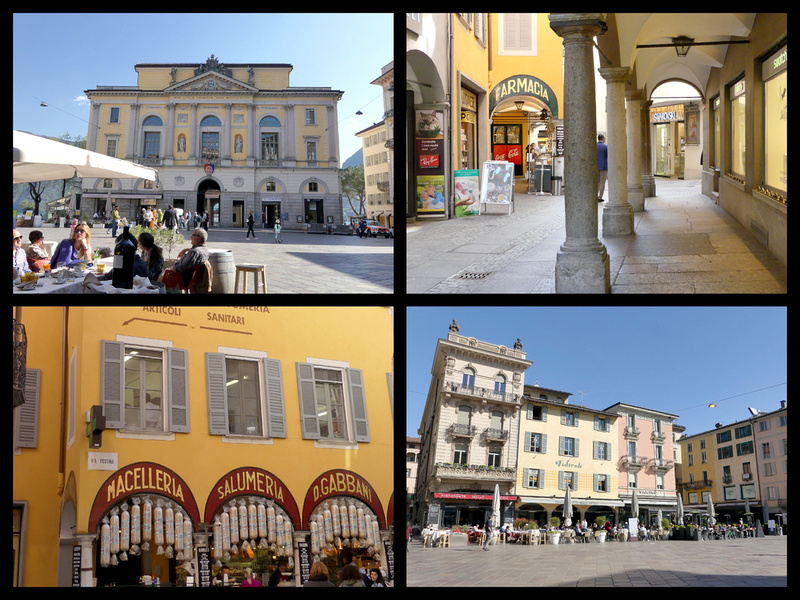





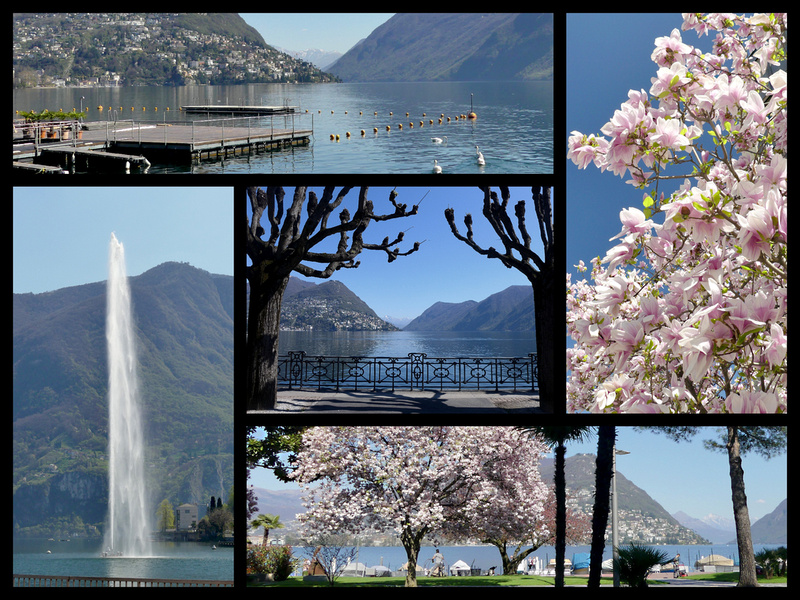



I took the funicular up to Monte San Salvatore (26 Swiss francs, took credit cards). Fabulous views. The view is definitely better if you walk the five minutes from the top of the funicular station to the top of the church (there’s a viewpoint up there). The views from the ‘terrace’ at the restaurant at the funicular station are nothing compared to those five minutes further up. They had an interesting display of Swiss Tourist Posters from the last hundred years all along the walk up to the viewpoint.
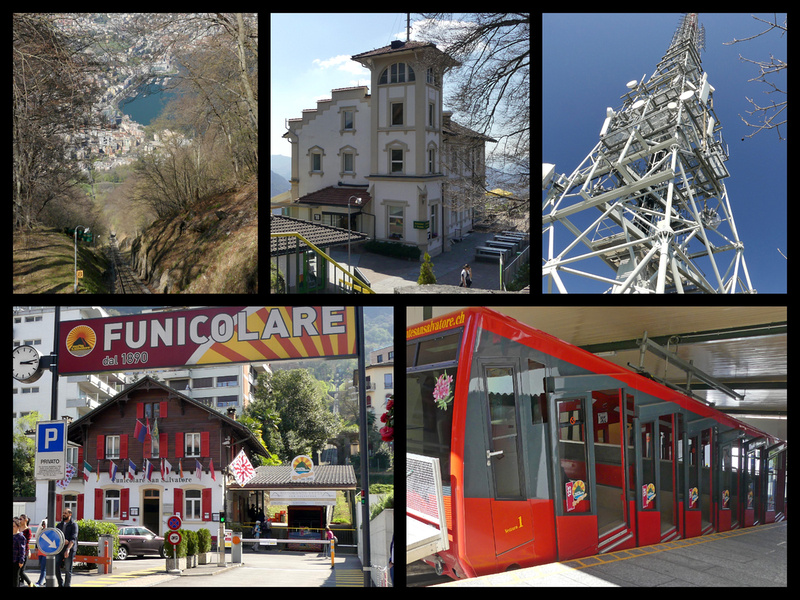



I was unable to get anything to eat as I had no Swiss francs. I could have gone to an actual restaurant which took credit cards but I had my ham and swiss croissants and water so all I really wanted was a smoothie or something but that was not worth taking money out of an ATM for since I was there just for the day.
The train situation was interesting. On the way there I had to buy a ticket with seat assignment and it was just like all the other train trips I’d been taking in Italy. Very orderly. At the border some immigration and border control guards got on the train and walked through checking random passports (a nice looking blond –e.g. they were not profiling potential immigrants - across the aisle was checked but no one else in our row). On the way back it was just a ‘ticket’ (no seat assignment). Much more crowded and kind of chaotic – the exact opposite from previous train trips in which Swiss trains were super orderly and on time and the Italian trains not so much. They announced they would be checking identity cards but I didn’t every see anyone.
Thursday, March 30, 2017 Sunny and 80 – Spent the day in Milan.
I had not expected it to be so hot so of course was over dressed. But it was an absolutely gorgeous day. I walked from the hotel to the Duomo, through the Public Garden (which was OK, nothing great except it was the perfect trees just leafing out so everything is that luscious green color and the sky was intense blue), then checked out the Venetian Gate – two mid 19th century buildings, again, OK but not something to go out of your way for. Normally when I stay at Hotel Berna I take the metro the two stops to the center, but it is totally walkable if you aren’t in a hurry.
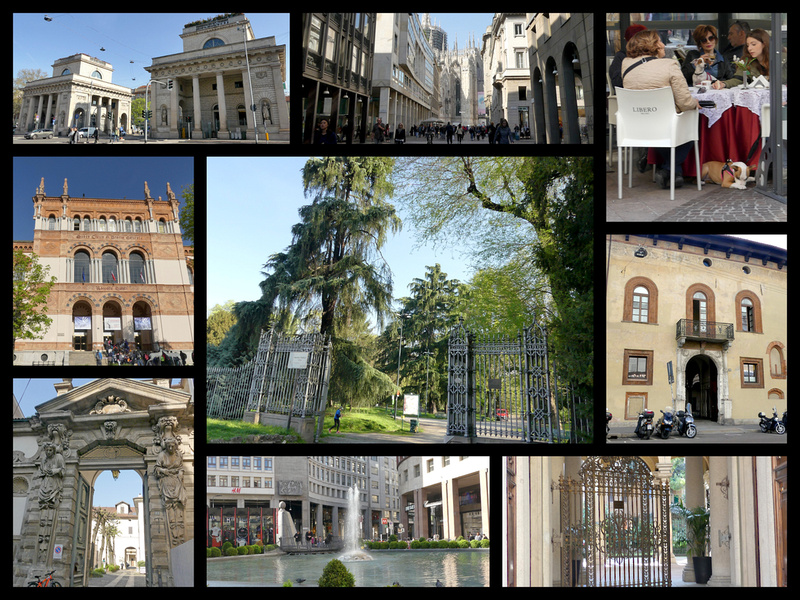

The Corso Venezia is one of Milan's most prestigious streets, bordered by stately buildings in a multitude of architectural styles, from Renaissance to Art Nouveau. It's about 1 km long and runs north from Piazza San Babila to Porta Venezia, and iis bordered by the Giardini Pubblici, one of the few public parks in the center of Milan.Just inside the park is the Museum of Natural History. From Piazza San Bablia to the Duomo is a short pedestrianized street filled with shopping options.


The last of Italy's great Gothic structures, Milan's Duomo took over 500 years to complete. Begun by the ruling Visconti family in 1386 – it is one of the ten largest cathedrals in the world, with 135 marble spires, a stunning triangular facade, and over 3,400 statues flanking the massive but airy, almost fanciful exterior. From the roof are stunning views of the flying buttresses up close as well as views over Italy’s most frenetic city.
Every time I've been to Milan I've gone to the Piazza del Duomo. For one thing it's an amazing sight, but it's also very much in the center of the city. Walking around the Duomo and through the Galleria is a 'must-see' whenever you are there. I'd been inside the Duomo on a previous visit but had never gone up to the roof.
There was at least a 15-minute line to buy tickets for the Duomo, I just got the roof access as they are now charging for the Duomo interior as well and since I’ve already been in there and it was such a gorgeous day I wanted to be outside. Then another 15-minute line for the lift plus some serious security. There’s a bit of construction going on up there so a good deal was under scaffolding – not terribly noticeable from the ground but it was from up there. Still, interesting to see the flying buttresses up close and the views of the piazza in front, etc.
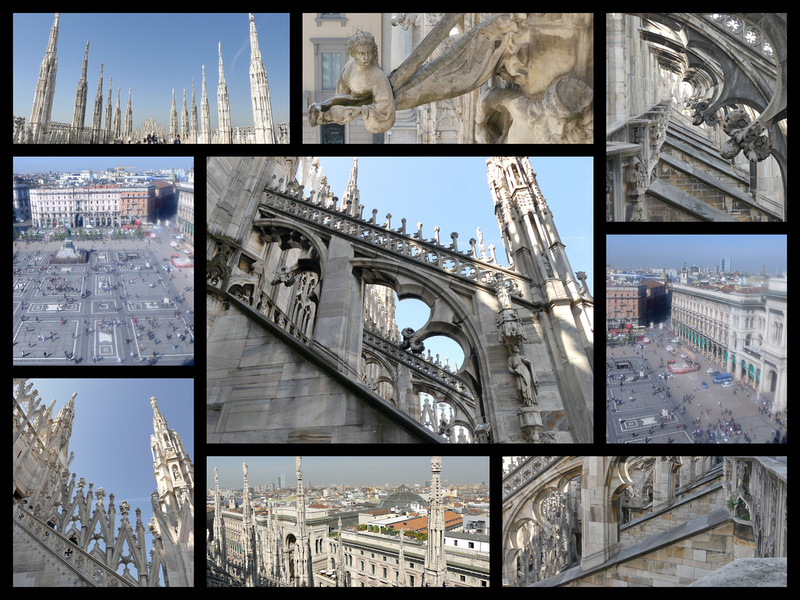

Galleria Vittorio Emanuele is a spectacular, late-19th century glass-topped, belle époque, barrel-vaulted tunnel. It is essentially one of the planet's earliest and most select shopping malls, the prototype of the enclosed shopping malls that were to become the hallmark of 20th century consumerism, and of course none of those have come close to matching the Galleria for style and flair. This is the city's heart, midway between the Duomo and La Scala, an important meeting and dinning place. Like the cathedral, the Galleria is cruciform in shape. The great glass dome above the octagonal center is a splendid sight. The paintings at the base of the dome represent Europe, Asia, Africa, and America. The Galleria has always been home to luxury retailers like Prada but until 2013 there was also a McDonald’s in there. It was prevented from renewing it’s lease (after 20 years) and sued the city. McDonald’s is now located just outside the Galleria and it’s former space is occupied by a second Prada store. The entrance from the Piazza del Duomo is framed by a monumental triumphal arch, drawing people in from the square in front of the cathedral in.
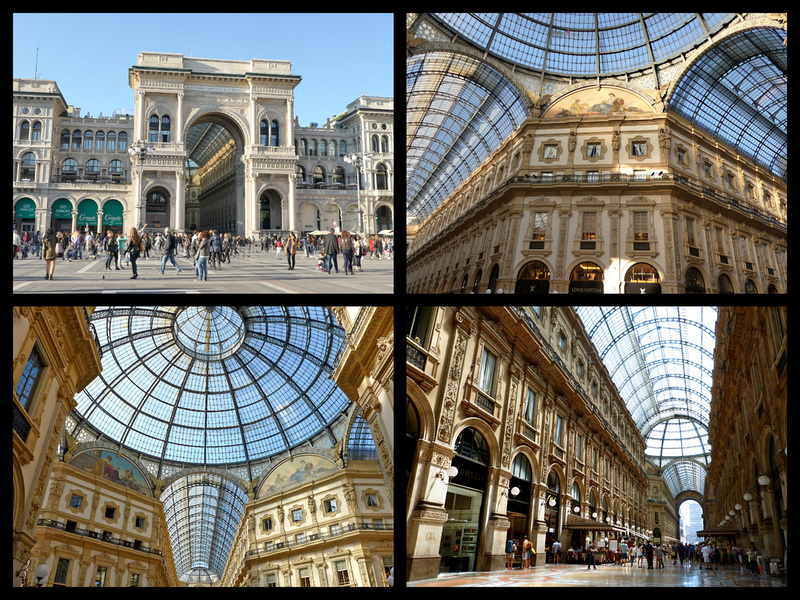

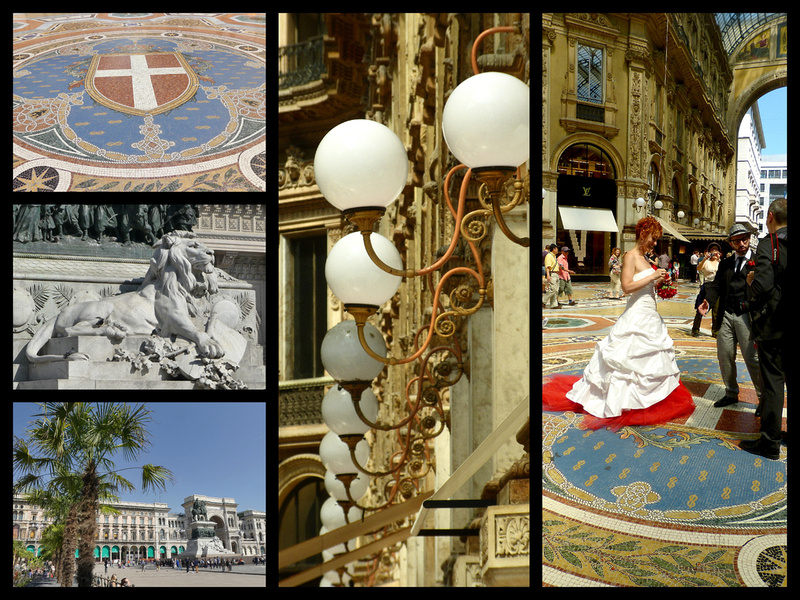

The Galleria was constructed during the era of Italian unification and symbolized Italian unity, so it was decorated with patriotic symbols. Mosaics on the floor below the dome depict the coat of arms of Savoy and Italian cities are allegorically represented: a wolf for Rome, a lily for Florence, a bull for Turin and a white flag with red cross for Milan. Stepping with the heel of your foot on the genitals of the bull is supposed to bring good luck.
Just off the Piazza del Duomo is what is left of medieval Milano, now just a small Piazza (Mercanti) with a couple of buildings including the Palazzo della Ragione (1228) and the Loggia degli Osli (1316), and Palazzo dei Giureconsultli (with the clock tower) . From there, Via Dante is a pedestrianized shopping street full of restaurants and cafes that runs to the castle.
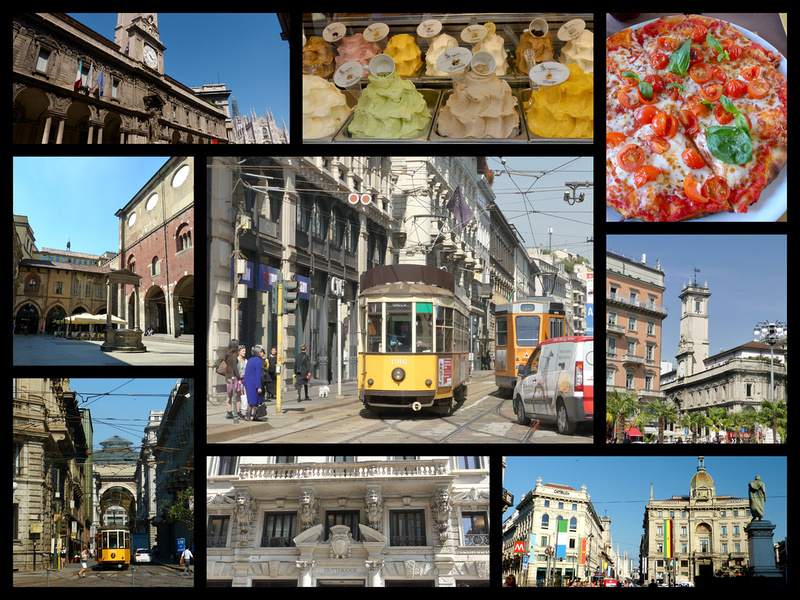

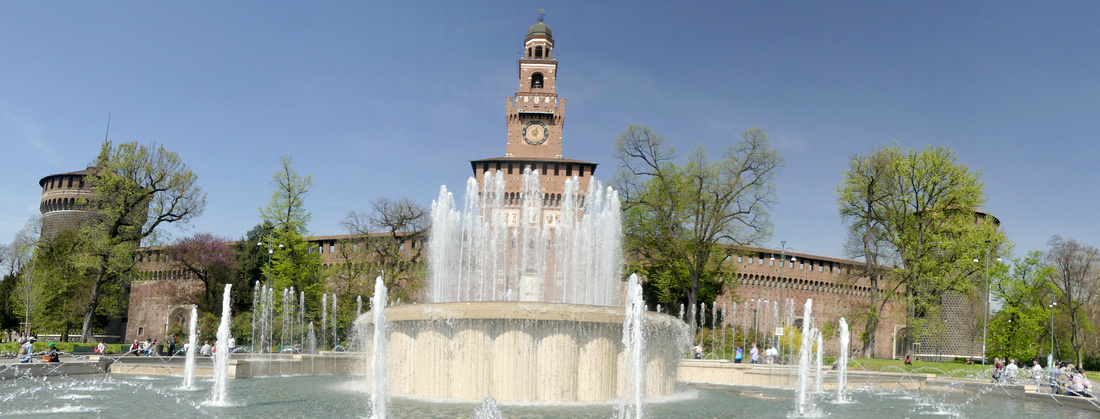

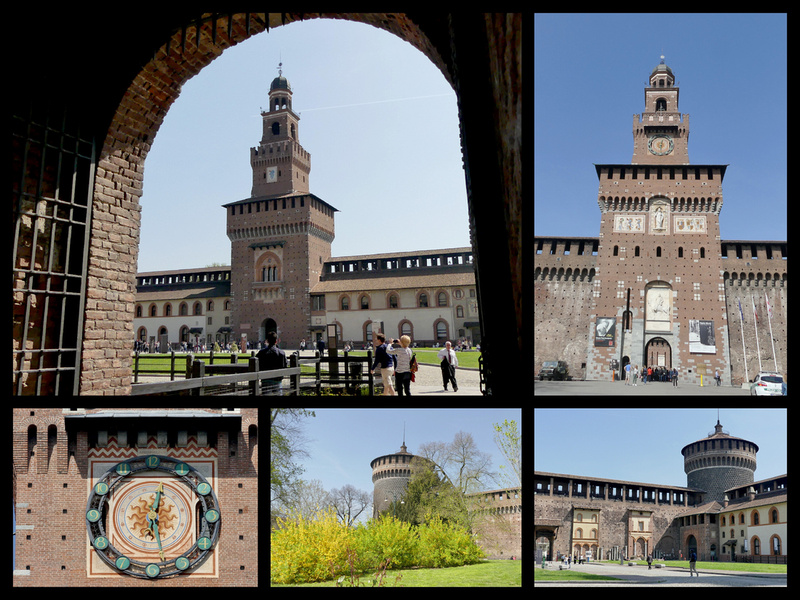

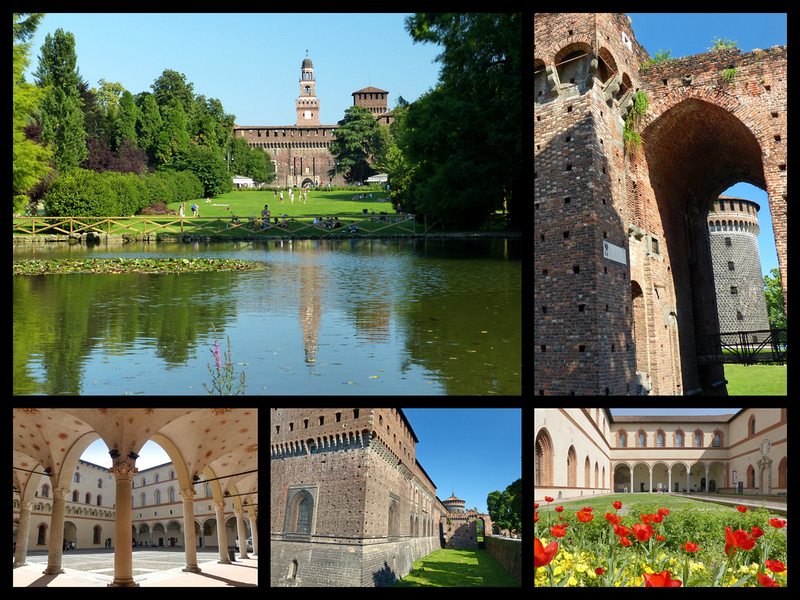

Castello Sforzesco, begun in 1358 and expanded several times through the 1400s. The present castle, with a square plan laid out around three inner courtyards , is dominated by its many towers. The main entrance leads through the castle's tallest tower - the Torre del Fiarete - to the Piazza d'Armi, an expansive inner courtyard. Behind this tower is the heart of the castle with the palatial residences of the Sforza dukes enclosing two smaller courtyards. Castello Sforzesco is home to a number of museums, but the grounds are free to wander through.
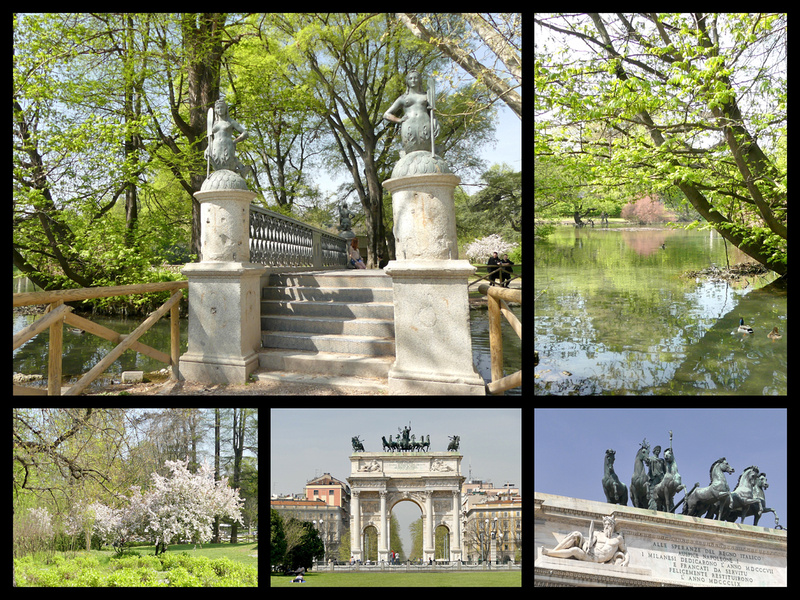

The sun was shining beautifully on the front of the castle and the fountain in front was going. I ate my croissant with ham and cheese and cherry tomatoes along with a limone granite sitting on the bench around the fountain. After wandering around the castle grounds for a while I made my way into the park, sat for a while in the sun (too hot to linger). Parco Sempione is a nicely laid out 116 acre park in a landscape style with winding paths, open grassy areas, tall trees and a picturesque bridge across a central pond which usually nicely reflects the castle. Everything was in bloom and it was just lovely.
I then checked out the Arco della Pace, which was originally a triumphal arch and looks very similar to the Arc de Triomphe du Carrousel in Paris, the smaller cousin to the more famous Arc de Triomphe which sits at the far end of the Champs-Elysees. Arco della Pace sits at the site of one of Milan's town gates, which was originally the entrance to the city from the road which led to Paris.
From there I managed to walk to the Cemetery without getting lost (the map I had printed out was actually very detailed). The Cemetery, billed as Italy’s Pere LaChase, does have a lot of very fancy statues and little buildings/tombs but as far as I know no one famous is buried there. The huge main building was pretty impressive as well.


Then I debated walking or taking the metro back to the hotel. By the time I got to the metro stop I wanted it looked like I wasn’t all that far but it turned out to be a bit of a slog. Passed some of the new shinny glass office complexes, something I don’t usually see in European cities as they, fortunately, tend to be segregated in the outskirts.
The last evening in Milan I enjoyed the beautiful way major monuments in European cities are lit and the way they glow golden against the dark blue sky.
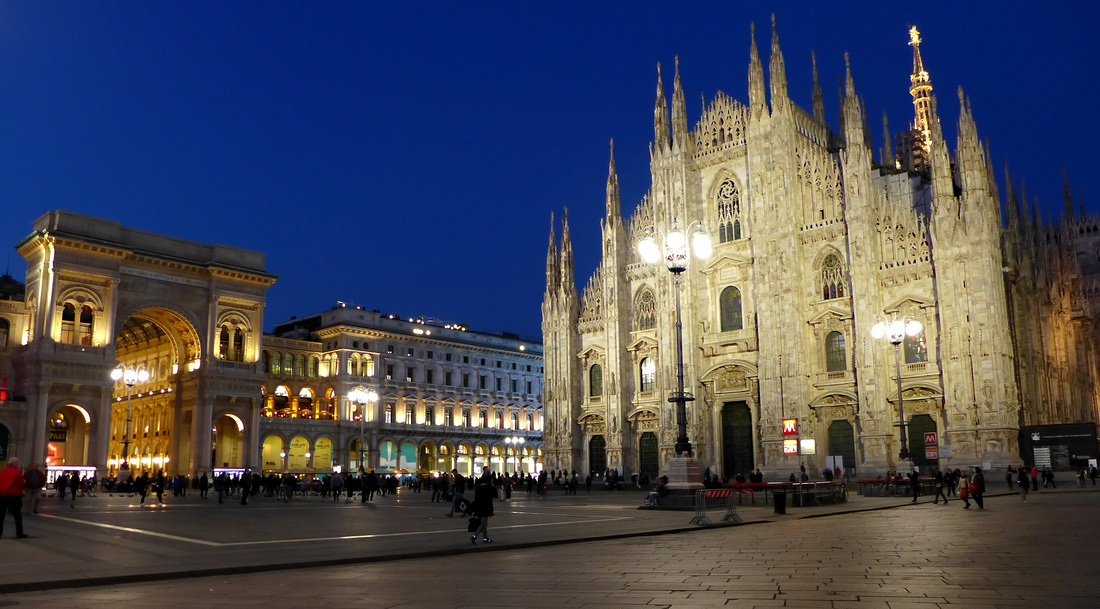



For the Venice, Florence, and Rome portions of my trip see "Italy through Fresh Eyes: Chasing the Sun in Italy in March" Parts 1, 2, and 3
For more photos click on "All Photographs in the upper right corner and navigate to the Italy gallery.